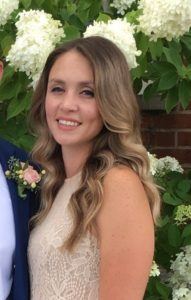Kayla H. Sickles, MHA, RDCS, RVT, RDMS
Cardiac and vascular sonographer at Highland Hospital of Rochester, NY.
 I am an advocate of incorporating foundations of all sonographic modalities into sonographer education. A sonographer with breadth of knowledge is more likely to have the ability to identify and correctly report incidental findings that may dramatically alter patient outcomes and even save lives. Yet, as the field of ultrasound advances, dual-registered sonographers are becoming less common and triple-registered sonographers are a rarity. Twenty-five percent of sonographers registered through the ARDMS have earned two credentials and only four percent have three or more credentials.
I am an advocate of incorporating foundations of all sonographic modalities into sonographer education. A sonographer with breadth of knowledge is more likely to have the ability to identify and correctly report incidental findings that may dramatically alter patient outcomes and even save lives. Yet, as the field of ultrasound advances, dual-registered sonographers are becoming less common and triple-registered sonographers are a rarity. Twenty-five percent of sonographers registered through the ARDMS have earned two credentials and only four percent have three or more credentials.
The specialization of medicine certainly has many advantages; however, it might also reduce the clinician’s ability to see the entire clinical picture outside of his or her scope of practice. For sonographers this means we may be losing our ability to “see” the entire window in which we are scanning. For example, I have noticed that new sonographers whose education focused extensively on cardiovascular systems are less able to recognize normal non-cardiac anatomy and incidental findings they will most certainly encounter throughout their careers.
My diverse sonography experience and education occurred almost by accident. I attended Rochester Institute of Technology in Rochester, NY, where I studied in the general ultrasound program. Upon graduation I was eligible to sit only for the RDMS credential. Immediately after graduation, I was hired for a temporary position as a general sonographer in the radiology department of a small rural hospital. I soon learned that general at a small hospital meant everything and everyone. Outside of the normal abdominal and small parts exams, radiology provided services for vascular surgery, obstetrics and gynecology, pediatrics, neonatal patients, and the breast clinic. I was forced to further educate myself as a sonographer and dive deep into other modalities.
Since then, I have earned the RDCS and RVT credentials. I now work full time as a cardiac and vascular sonographer, and am grateful for the experience I gained at my first job. When I scan, I see the entire window, gallstones and all. With a wide scope of knowledge and experience, I have been able to report incidental findings such as malignancies that likely would have gone unnoticed by someone who focused on just the written orders. I have also solved a few mysterious cases of chest pain by incidentally discovering cholecystitis during a “stat” stress test.
From a professional perspective, earning additional ARDMS credentials is a huge advantage. More credentials mean more employment opportunities. Echocardiology labs often prefer to hire sonographers with both the RDCS and RVT credentials as they often provide both cardiac and vascular ultrasound services. In general, additional ARDMS credentials do not require addition CMEs to maintain your credentials. From a patient care perspective, the education and experience required to sit for each additional board exam means increased sonographic knowledge and the ability to see and identify a larger scope of disease.
My career as a sonographer has brought great meaning to my life both professionally and personally. The best part of this career is having the ability to make a difference in someone’s life, whether it be through bedside manner or clinical excellence. I know I have made a difference in my patients lives by being able to provide them with the best care possible as a multi-modality registered diagnostic medical sonographer.